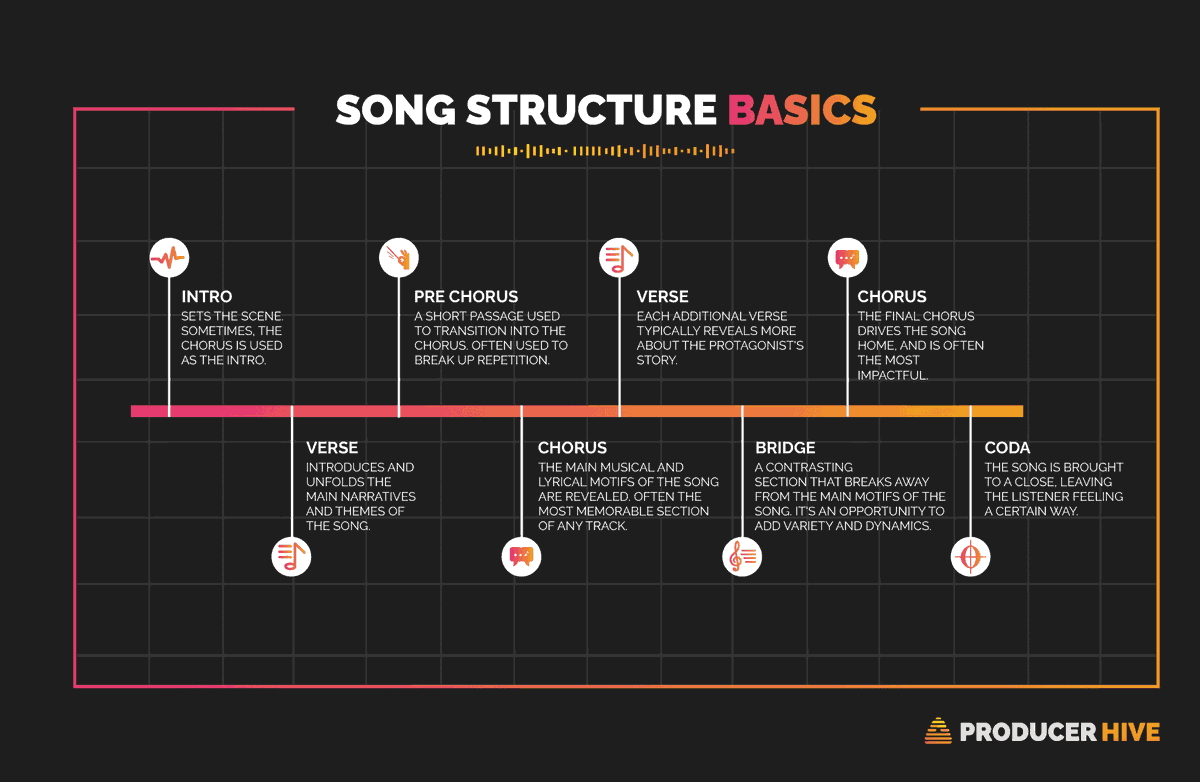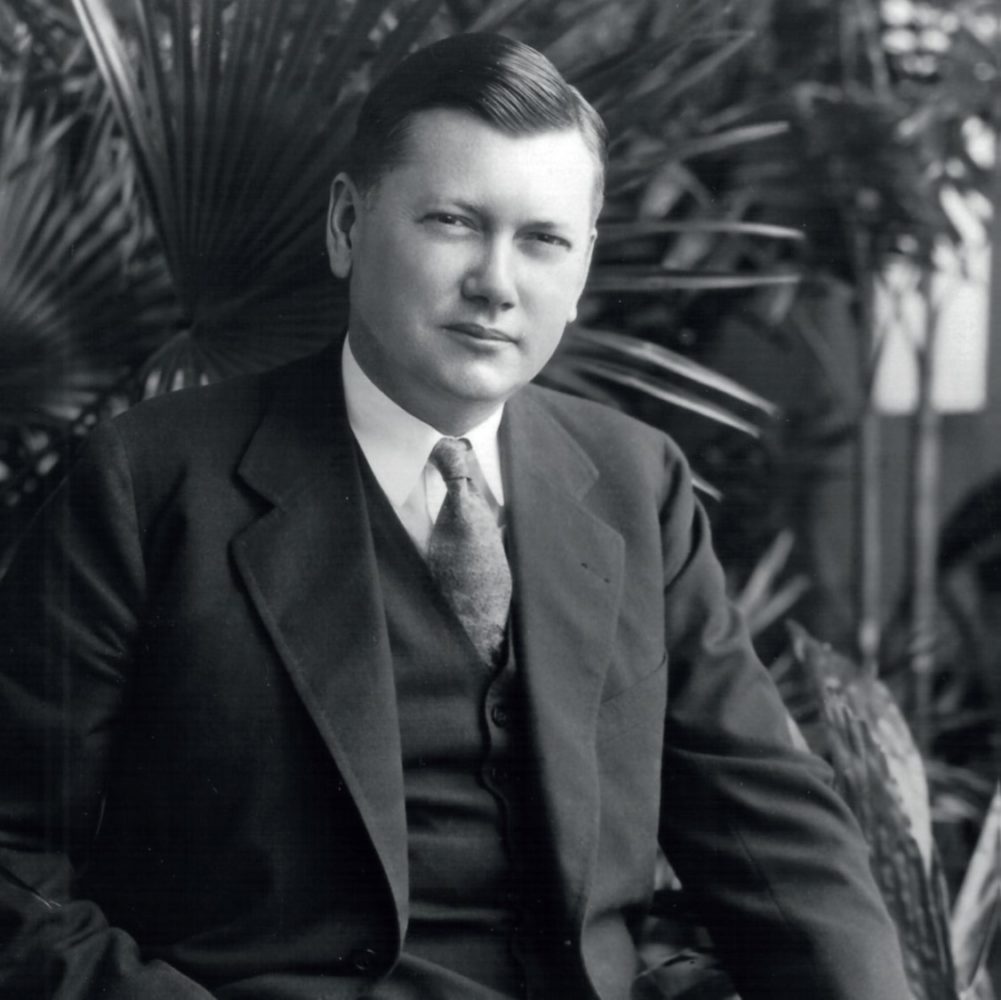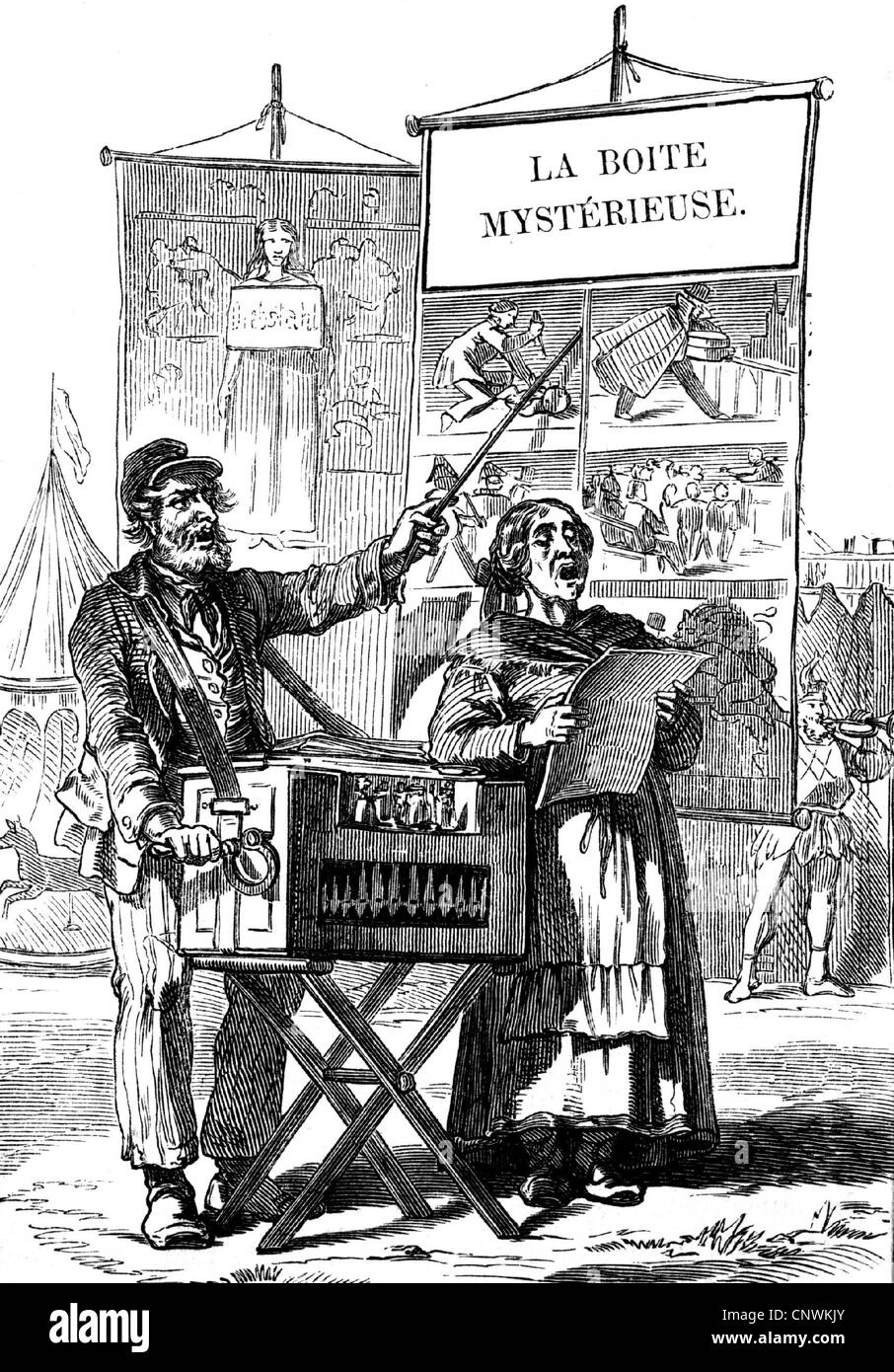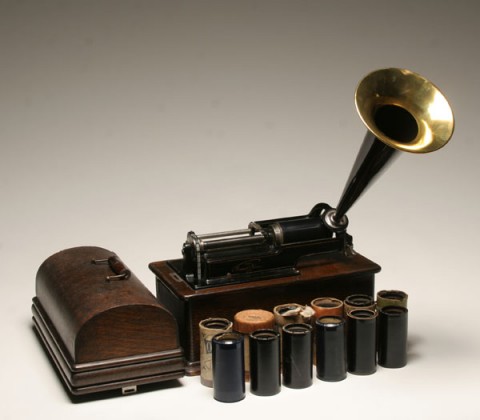During the 1920s and 1930s, composers and lyricists fused earlier song structures to produce a verse-refrain form which, in the hands of more inventive composers, allowed for all sorts of interesting variations. How does a song’s form affect its style or musical interpretation?
What is a Song Form
Simply . . . Song Form arranges the structure of songs into an easy to understand framework. Song structure is important because it organizes how songs are written while aiding in how they are recognized and appreciated. Without a song having shape, songs are can become chaotic and unlistenable.
Why is this important? Simply, song form, allows the story to be told so that people listening can better understand and enjoy the experience of the song.
You don’t have to reinvent the wheel in order to be creative, however. That’s where song form comes into play. Think of the most common types of song structures as universally agreed upon roadmaps for songs.
Song Form reveals to us where the song is going.
Consider that song form helps song writers keep an overview of songs and how sections of music that make up the song will be organized.Imagine song form as a map made up of locations that we know of as verses, choruses and bridge.
What are the parts we are generally concerned with then;
- Verses are similar but differ slightly from each other
- Chorus often differs from verse
- Bridges can be very different
When discussing song forms, a system of letters are assigned to the different sections of a song. Repeated sections get assigned the same letter as was assigned on the first occurrence of that section. The letters then create a map of the overall song.
The assignment of letters is not what you would think, however. We don’t use the first letters of “V” for Verse, “C" for Chorus or “B” for Break, but rather the first letters of the alphabet.
For example ;
A=Verse
B=Chorus
C=Bridge
Strophic / AAA / One-Part Song Form
Strophic . . . What was that? Strophic describes how each verse is sung to the same tune.
Strophic Song Form is also called AAA Form or One-Part Song Form. AAA song form is one of the oldest sectional song forms. How far back does it go? Originally it was used in the adaption of poems, with composers setting the poems to music to perform them for the entertainment of the royal courts of Europe.
In Mary Had A Little Lamb has a melody which is repeated, in Strophic Song Form, and each time the melody repeats different words are sung to the melody. This makes it an ideal song form for story telling.
The nursery rhyme was first published by the Boston publishing firm Marsh, Capen & Lyon, as a poem by Sarah Josepha Hale on May 24, 1830, and was possibly inspired by an actual incident
- “Mary Had a little lamb" by Stevie Ray Vaughn 1983, Traditional
- “Mary Had a little lamb" by Stevie Ray Vaughn 1983, Traditional
AAB Form - 12 Bar Blues
The 12-bar blues form used in the AAB song form is strongly associated with the blues. Many Blues songs are in the AAB format.
The fundamental structure of 12 Bar Blues is three four-bar lines or sub-sections. Often the first two and a half bars of each 4 bar section are vocal melody, while the last one and a half bars contains an instrumental melodic hook that gives a sense of completion for the line.
Unlike AAA or AABA song forms, which describe the overall structure of the song, AAB describes the structure of an individual verse. AAB is always used as a compound form.The common variants for 12-Bar blues are 8-Bar form and 16-Bar form.
Elmore James played a modified “Kay” hollow-body acoustic guitar, which sounded like an amped-up version of the more "modern" solid-body guitars of today.
- “Dust My Broom" by Elmore James 1959, originally by Robert Johnston 1936
- See this article on the evolution of heavy metal sound
AABA Song Form / American Popular Song Form
This is one of the most commonly used forms in both jazz and early to mid-twentieth-century popular music.
The AABA format was the song form of choice for Tin Pan Alley songwriters of American popular music, an East Coast USA songwriter scene based in New York City, in the first half of the 20th century.
Tin Pan Alley songwriters included songwriting greats like Irving Berlin, Harold Arlen, Sammy Cahn, Hoagy Carmichael, Dorothy Fields, Johnny Mercer, George and Ira Gershwin.
The dominance of the AABA song form faded during the 1960s. The rise in popularity of rock 'n' roll and the rise of groups like The Beatles changed the popular music landscape. Before The Beatles broke off into other song writing formats, they heavily used AABA song form in many songs.
It uses this song form in several music genres including pop, jazz and gospel.
- “Over the rainbow by “Judy Garland" 1938,
- Wizard of Oz movie
- Eight Days A Week by the “Beatles”
Housekeeping; Euphemisms: where an unpleasant or offensive thing is described or referred to by a milder term.
The promotional catchphrase “race music” was first applied by Ralph Peer (1892-1960), a Missouri-born talent scout for Okeh Records.
"Hillbilly" is a term (often derogatory) for people of various ethnicities who dwell in rural, mountainous areas in the United States, primarily in southern Appalachia and the Ozarks. The label, coined in 1925 by country pianist Al Hopkins, persisted until the 1950s.Although a clear distinction can be drawn between race music and hillbilly music — each of which comprised dozens of specific styles — the two had several important features in common.
- Both bodies of music originated mainly in the American South and
- rooted in longstanding folk music traditions.
As they entered the mass marketplace, both blended these older rural musical styles with aspects of national popular culture, including the minstrel show, vaudeville, and other musical forms.
Race music and hillbilly music both grew out of the music industry's efforts to develop alternative markets during a national decline in record sales.
Music was now disseminated across the country by new forms of media including;
- electric recording,
- radio, and
- sound film
and by the process of urban migration, which affected the lives of millions of rural Americans during the 20s and 30s.
Both bodies of music provided the basis for forms of popular music that emerged after World War II (rhythm & blues, country and western, and rock ”n” roll ), extending their appeal across regional and, in the end, international boundaries.
Jazz's attraction as a symbol of
- sensuality,
- freedom,
- and fun
does appear to have transcended the boundaries of
- region,
- ethnicity,
- and class,
Creating a precedent for music phenomenas such as
- swing era music,
- rhythm & blues,
- and rock ”n” roll.
“Hillbilly music,” later rechristened “country and western music” or simply “country music,” developed mainly out of the folk songs, ballads, and dance music of immigrants from the British Isles.
The first generation of hillbilly recording artists was also familiar with the sentimental songs of Tin Pan Alley, and this material became an important part of the country music repertoire, alongside the older Anglo-American ballads and square dance tunes.
Recordings of the late 1940s and early 1950s included swing-influenced “jump bands,” Tin Pan Alley-style love songs performed by crooners, various styles of urban blues, and gospel-influenced vocal harmony groups. The reappearance of small independent record labels provided an outlet for performers who were ignored by major record companies.
These jump bands specialized in hard-swinging, boogie-woogie based party music, spiced with humorous lyrics and wild stage performances.
Music from 1930s -1940s
- "Tiger Rag" by the Washboard Rhythm Kings 1932,
- was a virtually out-of-control performancer
- This is just one of many recordings by spasm bands, jug bands, and skiffle groups that have the same wild, informal feel that early rock-and-roll had.
- "Tiger Rag" had become a jazz standard and a widely covered song in the dance band and march orchestrations.
- "Oh! Red" by the Harlem Hamfats, recorded on April 18, 1936,
- was a hit record made by a small group of jazz and blues musicians assembled by J. Mayo Williams for the specific purpose of making commercially successful dance records.
- Viewed at the time (and by jazz fans) as a novelty group, the format became very influential, and the group's recordings included many with sex and drugs references
- "I Believe I'll Dust My Broom" (recorded on November 23, 1936),
- "Crossroad Blues" (recorded on November 27, 1936), and other recordings by Robert Johnson, while not particularly successful at the time, directly influenced the development of Chicago blues and, when reissued in the 1960s, also strongly influenced later rock musicians.
- "Rock It for Me" was recorded by Ella Fitzgerald with Chick Webb and His Orchestra in 1937.
- Its lyrics mentioned a kind of music called "rock-and-roll": "Every night/You'll see all the nifties/Plenty tight/Swingin' down the fifties/Now they're all through with symphony/Ho ho ho, rock it for me!/Now it's true that once upon a time/The opera was the thing/But today the rage is rhythm and rhyme/So won't you satisfy my soul/With the rock and roll?"
- "One O'Clock Jump" by Count Basie, arranged by Eddie Durham and recorded on July 7, 1937,
- based on a 12-bar blues that builds in rhythmic intensity and features, like many of Basie's other records, the rhythm section "all but invented the notion of the swing through their innovations"
- "Sing, Sing, Sing" by Benny Goodman, also from 1937,
- written by Louis Prima,
- featured repeated drum breaks by Gene Krupa, whose musical nature and high showmanship presaged rock and roll drumming.
- "Ida Red" by Bob Wills and the Texas Playboys, recorded in 1938
- Western swing band, featuring electric guitar by Eldon Shamblin.
- The tune was recycled again some years later by Chuck Berry in "Maybellene"
- "Rock Me" by the Lucky Millinder Orchestra with Sister Rosetta Tharpe vocals and guitar 1938,
- a gospel song done like a city blues
- the way she rolled the "R" in "rock me" led to the phrase being taken as a double entendre, with the interpretation as religious or sexual.
- "Roll 'Em Pete" by Pete Johnson and Joe Turner (1938)
- driving boogie woogie and a masterful collation of blues verses
- one of the most important precursors of what later became known as rock and roll
"Flying Home" by Lionel Hampton and his orchestra (1939),
- tenor sax solo by Illinois Jacquet,
- recreated and refined live by Arnett Cobb, the model for rock and roll solos ever since;
- emotional, honking,
- long, not just an instrumental break but the keystone of the song.
- The Benny Goodman Sextet had a popular hit with a subdued "jazz chamber music" version of the same song featuring guitarist Charlie Christian.
Since we can’t narrow our list of possible Rock & Roll candidates down to a two dozen or so, let’s see where it takes us.
Nick Tosches says it best | ”It is impossible to discern the first modern rock record, just as it is impossible to discern where blue becomes indigo in the spectrum."
So why so many think that Jackie Brenston made the first rock ‘n’ roll record? Well for a start, Sam Phillips was fond of telling people that it was.
Bringing you into the folds of the shows purpose, is to better understand where modern forms of popular music are evolving from and how their history has become entrenched in our modern music belief systems.
That’s not to say that we won’t dig through the bins and listen to some fabulous examples of bad music, or listen to the same song done by 20 different bands or look at why there are more than 500 songs that talk about chicken.
------------
Today we are calling bullshit on the origin of the first Rock & Roll song myth, or are we? Was it really just a fuzzy guitar sound hit upon by accident that made Rocket 88 the first Rock & Roll song? Or was it an evolution of events, people, styles, cultures and languages colliding. People have opinions, and there a more than a few regarding the first Rock & Roll song.
------------------
Arguably Canada and the United States were the perfect musical laboratory:
- take people from every corner of the globe,
- give them freedom to create.
- by sheet music,
- phonograph,
- radio
- CD,
- mp3,
- Or through services like Spotify and iTunes.
Then Distribute their effort by:
There exists a purely North American set of popular “musics.” Blues, Jazz, Country and Rock & Roll.
Until the mid 1800s, American popular music was for the most part entirely European in distinctive features. The English culture, language, society and commercial interests meant that their music established early on a kind of “mainstream” around which other styles orbited. Notwithstanding, Irish, Scottish, and Italian songs also influenced mid 19th C American popular music.
During this period, If the music wasn’t based upon a purely formal European tradition, such as hymns, traditional folk songs or established Operatic scores, the music was usually was born out of urban experience and concerned with current events.
Ballads could be heard for the first time, usually by “Ballladmongers” who sung the compositions as they were hawking their collection of broadsides. Typically the words were printed on a large sheet, without musical notation, so it was important for the buyer to hear it sung or as in many cases the songs were set to already familiar melodies.
So why is this important? First and foremost it exemplifies the divisions which were growing apparent within society, especially after the American Civil War. Populations began to shift. Industrialization would begin driving rural white and African Americans to urban settings in search of work and a better life. This migration is where rock & roll really gets its start. We then add in The folk and popular styles brought by immigrants from other parts of Europe during subsequent waves of immigration from every continent. Just for perspective, between 1880 and 1910 an additional 17 million immigrants entered the United States.
Not all immigrants came willingly however. Between one and two million Africans were forcibly brought to the United States between the 17th and 19th centuries.
The genesis of African-American music in the United States involved two closely related processes.
The first of these was syncretism, as my first year Psych prof used to say after every he used some fancy new term . . . “What was that?”
Syncretism, the selective blending of
- traditions,
- music,
- religion
- and language,
in this case derived from Africa and Europe.
The second was the creation of institutions that became important centers of black musical life
- the family,
- the church,
- the voluntary association,
- the school, and so on.
Is it misleading to speak of “black music” as a homogeneous entity or thing. African-American culture took different forms in Brazil, Cuba, Haiti, Jamaica, and the United States, shaped in each by the particular mix of African and European source
As in the United States, musicians in Latin America developed a wide range of styles also blending African music with the traditions of Europe. Caribbean, South American, and Mexican traditions have long influenced popular music in the United States. With migration facilitated to America by the presence of of vast shipping needs of the industrialized societies, access to new lifestyles customs, traditions, heritage, habits, would emerge to offer another angle in this inevitable collision.
Is Rock & Roll just a term, a series of words, a popular phrase? The origins of the expression we use to describe Rock & Roll dates back to the 16th C. The phrase "rocking and rolling" may have originally described the movement of a ship on water, but by the early 1900s, its meaning had changed to encompass and describe both a spiritual fervor and as a sexual analogy.
- The Camp Meeting Jubilee - 1896, Unknown Artist, Cylinder recording
"Rocking" was used to describe the spiritual rapture felt by worshippers at certain religious events, while it also came to refer to the rhythm often found in the accompanying music.
Eventually by 1896 the words began to appear in recordings, most notable are the versions of the song “The Camp Meeting Jubilee” sung by both the Edison male and Columbia Quartettes.
The classic examples ”They had a roll in the hay" or "I rolled her in the clover" which date back hundreds of years. Rock “n” roll was little more than a euphemism among the Black population in early 20th Century America.
“My Daddy Rocks Me (with one steady roll); as clear evidence as you can get for the link between rock and roll, and sex.
Music 1920-1930
- Trixie Smith along with the Jazz Masters - “My Daddy Rocks Me (with one steady roll); September 1922 in New York City
- the first record to refer to "rocking" and "rolling" in a secular context
- Papa Charlie Jackson recorded "Shake That Thing" in 1925.
- "That Black Snake Moan", a country blues first recorded in 1926 by Blind Lemon Jefferson,
- contains the lines "That's all right mama / That's all right for you / Mama, that's all right / Most any old way you do", later famously used by Arthur Crudup for his song "That's All Right",
- subsequently covered by Elvis Presley as his first single.
- Arthur Crudup for his song "That's All Right",
- "Honky Tonk Train Blues", by Meade "Lux" Lewis 1927
- foreshadowed "Pine Top's Boogie Woogie" a year later, perhaps not coincidentally since Lewis and Pine Top had recently been roommates.
- it contained most of the elements that would be called Rock and Roll thirty years later, except with piano instead of guitar.
- "Sail Away Ladies" and "Rock About My Saro Jane" were recorded by Uncle Dave Macon and his Fruit Jar Drinkers on May 7, 1927.
- "Sail Away Ladies" is a traditional square dance tune, with, in Macon's version, a vocal refrain of "Don't she rock, daddy-o", which in other versions became "Don't you rock me, daddy-o".
- "Don't You Rock Me, Daddy-o" later became a hit in the UK in 1957 for both the Vipers Skiffle Group and Lonnie Donegan. Macon is thought to have learned the song "Rock About My Saro Jane" from black stevedores at Nashville in the 1880s, although Alan Lomax believed that the song dated from the mid-19th century.
- "Jim Jackson's Kansas City Blues" by Jim Jackson, recorded on October 10, 1927,
- was a best selling blues, suggested as one of the first million-seller records.
- Its melody line was later re-used and developed by Charlie Patton in "Going to Move to Alabama" (1929) and Hank Williams ("Move It on Over") (1947) before emerging in "Rock Around the Clock", (1954)
- its lyrical content presaged Leiber and Stoller's "Kansas City".
- It contains the line "It takes a rocking chair to rock, a rubber ball to roll," which had previously been used in 1924 by Ma Rainey in "Jealous Hearted Blues",[50] and which Bill Haley would later incorporate into his 1952 recording "Sundown Boogie."
- Charlie Patton in "Going to Move to Alabama" (1929)
- Hank Williams ("Move It on Over") (1947)
- Bill “Haley and his Comets - Rock Around the Clock", (1954)
- Albert King - "Kansas City" (195x)
- "Pine Top's Boogie Woogie" by Clarence "Pinetop" Smith, recorded on December 29, 1928,
- was one of the first hit "boogie woogie" recordings, and the first to include classic rock and roll references to "the girl with the red dress on" being told to "not move a peg" until she could "shake that thing" and "mess around".
- Smith's tune derives from Jimmy Blythe's 1925 recording "Jimmy's Blues", and earlier records had been made in a similar style by Meade "Lux" Lewis and others.
- A hit "pop" version of Smith's record was released by Tommy Dorsey in 1938 as "Boogie Woogie".
- "Crazy About My Baby" by Blind Roosevelt Graves and brother, Uaroy, recorded in 1929, was a rhythmic country blues with small group accompaniment.
- Researcher Gayle Dean Wardlow in his book “Chasin' That Devil Music," has stated that this "could be considered the first rock 'n' roll recording".
- The Graves brothers, with an additional piano player, later were recorded as the Mississippi Jook Band, whose 1936 recordings including "Skippy Whippy", "Barbecue Bust" and "Hittin'the Bottle Stomp" were highly rhythmic instrumental recordings which, according to writer Robert Palmer, "..featured fully formed rock and roll guitar riffs and a stomping rock and roll beat"
During the 1920s and 1930s, composers and lyricists fused earlier song structures to produce a verse-refrain form which, in the hands of more inventive composers, allowed for all sorts of interesting variations.
While the verse came to be regarded as mere introduction, the refrain, the part that is usually considered “the song,” typically comprised four sections of equal length, in the pattern A B B A.
The promotional catchphrase “race music” was first applied by Ralph Peer (1892-1960), a Missouri-born talent scout for Okeh Records.
Although a clear distinction was drawn between race music and hillbilly music — each of which comprised dozens of specific styles — the two had a number of important features in common.
- Both bodies of music originated mainly in the American South and
- rooted in longstanding folk music traditions.
As they entered the mass marketplace, both blended these older rural musical styles with aspects of national popular culture, including the minstrel show, vaudeville, and other musical forms.
Race music and hillbilly music both grew out of the music industry”s efforts to develop alternative markets during a national decline in record sales and were disseminated across the country by new media — including electric recording, radio, and sound film — and by the process of urban migration, which affected the lives of millions of rural Americans during the 1920s and 1930s. And both bodies of music provided the basis for forms of popular music that emerged after World War II (rhythm & blues, country and western, and rock ”n” roll ), extending their appeal across regional and, in the end, international boundaries.
Jazz”s attraction as a symbol of sensuality, freedom, and fun does appear to have transcended the boundaries of region, ethnicity, and class, creating a precedent for phenomena such as the swing era, rhythm & blues, and rock ”n” roll.
“Hillbilly music,” later rechristened “country and western music” or simply “country music,” developed mainly out of the folk songs, ballads, and dance music of immigrants from the British Isles.
The first generation of hillbilly recording artists was also familiar with the sentimental songs of Tin Pan Alley, and this material became an important part of the country music repertoire, alongside the older Anglo-American ballads and square dance tunes.
Recordings of the late 1940s and early 1950s included swing-influenced “jump bands,” Tin Pan Alley-style love songs performed by crooners, various styles of urban blues, and gospel-influenced vocal harmony groups. The reappearance of small independent record labels provided an outlet for performers who were ignored by major record companies.
These jump bands specialized in hard-swinging, boogie-woogie based party music, spiced with humorous lyrics and wild stage performances.




:format(jpeg):mode_rgb():quality(40)/discogs-images/A-313017-1522412209-5676.jpeg.jpg)









Social Media
Search Here